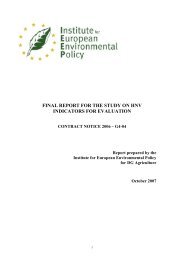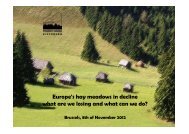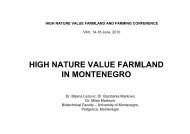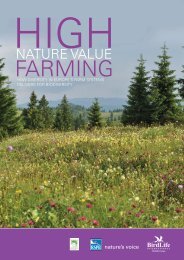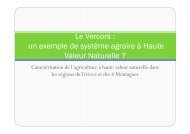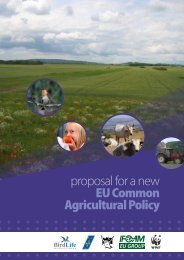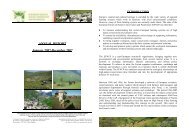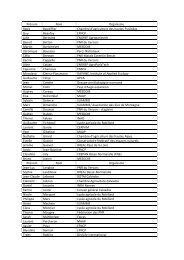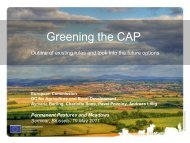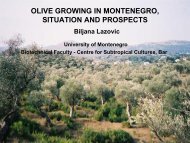Download
Download
Download
- No tags were found...
You also want an ePaper? Increase the reach of your titles
YUMPU automatically turns print PDFs into web optimized ePapers that Google loves.
Romanian HNV grassland<br />
(type 1) designation<br />
Sergiu Didicescu - Romanian<br />
Ministry of Agriculture and Rural<br />
Development - Bruxelles 15.05.08
Threats<br />
• Abandonment – the biggest threat that was, but somehow easier to tackle, CAP<br />
area based payments mixture are an efficient tool for tackling it.<br />
• Competition on farmland – Land is more attractive and not only for pure<br />
farmers. Occurrence of opportunity driven “sofa farmers”. Access to land<br />
acquisition easier for big farmers.<br />
• Changing land use and intensification.<br />
• Broader, market driven competition. Higher incomes in cities or abroad,<br />
increasing demand for labour force coming from these sectors.<br />
• Pressure from other economical activities INSIDE the countryside (e.g.<br />
constructions, tourism)<br />
Overall, HNV systems are among the less competitive systems, this being the<br />
biggest threat.
HNV Grassland Designation
Romanian LFA designation<br />
LFA România:<br />
- 657 mountain<br />
ATU’s<br />
- 24 significant<br />
handicaps<br />
ATU’s<br />
- 293 specific<br />
handicap ATU’s
Bird conservation package (type 3)
Designation<br />
• Follows Type 1 definition: “farmland with a high<br />
proportion of semi-natural vegetation”<br />
• That does not mean that it excludes the other<br />
types of HNV, current designation also covers<br />
many Type 2 mosaics as well as most of Natura<br />
2000 sites in Romania (which can be considered<br />
Type 3 HNVf)<br />
• An estimation of 2,4 mil. hectares surface falling<br />
within the current HNV designation.
Designation<br />
• Based on Corrine Land Cover approach<br />
• Check Keys<br />
- average LSU in the area 0,4<br />
- almost inexistent chemical fertilisers/pesticides application<br />
- LFA layer<br />
- Natura 2000 sites layer<br />
- Rich cultural heritage<br />
Existence of farm filter ! And key species monitoring!<br />
Is not “just a map”!<br />
Grassland Characteristics<br />
• Large species pool and very diverse<br />
• High gamma diversity-species<br />
• Grasslands sensitive to fertiliser and increased grazing
Romanian Designation<br />
There is still room for improving. But currently represents<br />
best value for money by meeting targeting requirements.<br />
Expert monitoring of species is in place and WILL prove<br />
it’s efficiency.<br />
Things for the future, developing the concept:<br />
EU wide definitions are NOT always the best definitions.<br />
A higher level of flexibility must be in place for the<br />
concept to be further successfully developed at each<br />
Member State level. Moving towards “result oriented”<br />
schemes, definitions less important.
National Cooperation<br />
• Current designation made in close cooperation with<br />
Romanian Grassland Institute and Universities<br />
• NGO’s were involved from the beginning of the<br />
designation process<br />
• Farmers associations involved<br />
• Other environmental institutions
Who are the farmers
Many thanks,<br />
Sergiu Didicescu<br />
Sergiu.didicescu@madr.ro<br />
Pictures by Andrew Jones



